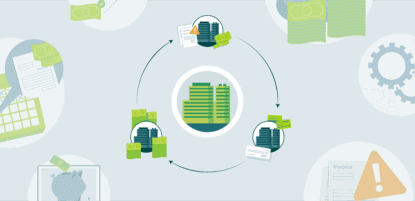Invoice capture is the process of extracting data from invoices and is an essential part of accounts payable. Yet, traditional capture processes present several challenges to an AP department if not managed properly. Best practices for invoice capture are achieved through automation with effortless capture, automated coding, and accelerated processes for approvals and payments. In this blog, we outline the current challenges of invoice capture and how automation can streamline the process of invoice payments.
What is Invoice Capture?
Invoice capture is the practice of collecting data from an invoice and entering it into an Enterprise Resource Planning (ERP) system, where it can then be processed. Businesses may receive invoices in a number of different forms–they may be sent electronically via email, sent as hard copy through the mail, or faxed, for example.
Regardless of how the invoice arrives at the AP department, the data from the invoice must be captured into an ERP system for bookkeeping. For many departments, capture is still a manual process requiring an employee to type in the details from each invoice into the ERP system.
Approving the invoice may also be manual and involve a physical paper copy moving from desk to desk for authorization. While this may not pose problems if invoices are few in number or the business is small, for any business that processes a large number of invoices, it can be quite cumbersome, time consuming, and lead to errors and late payments.
Other forms of invoice capture involve either using a system in which suppliers can directly submit invoices into the ERP system (using EDI, or Electronic Data Interchange, for example), or ones in which invoices can be easily scanned and entered without manual intervention.
Why is Invoice Capture Important?
When an invoice is captured, all of the data from the invoice is recorded. It is absolutely vital that it is recorded accurately during this step because errors result in compounding downstream effects. Errors in capture lead to errors in processing, errors in payment, errors in record keeping, and so on. This can result in problems with vendors getting paid correctly and on time, and ultimately fraught supplier relations.
Errors are much more likely to occur when invoice data is entered manually. Delays in invoice capture can also lead to duplicate invoices when the same invoice is re-sent due to lack of payment. If duplication leads to double payment, this can also hurt cash flow until the issue is resolved. If invoices come in many different forms–some electronically, some in the mail–capturing those invoices puts them all into the same system for centralized handling.
In other words, invoice capture is important because accurate data and timely processing of invoices is important and can impact a company’s bottom line.
What are the Challenges of Invoice Capture?
Different businesses use different methods to capture invoices. As previously mentioned, these methods may be manual, electronic, or a combination of the two. Here we outline some of the challenges that AP departments encounter with invoice capture:
Invoice Errors
Errors occur often with manual data entry, but also with less sophisticated automated systems that rely on OCR (optical character recognition) technology alone. The big issue with invoice capture errors are the cascade of downstream problems that result. Not only do those errors cause problems, but they take paid time to resolve and can lead to late payment fees and higher invoice processing costs.
Inefficient Manual Processes
When businesses are small or have very few invoices, manual processes may not seem like a big deal. But when such businesses grow, they may soon find themselves handling a painful number of invoices using methods that are time consuming and inefficient at scale.
As an example, the California Cancer Associates for Research and Excellence (cCare) was still manually entering invoice data even as their invoice numbers reached 1,000 a month. This required two employees spending 5-6 hours every day on data entry and invoice reporting. Invoice approval and tracking was also a challenge since the eight cCare clinics lacked real-time visibility into invoice status.
For many businesses, a growing number of invoices is not necessarily correlated with a growing number of employees, which means those businesses must process more invoices with the same staff. In situations in which an organization has multiple offices, each with their own AP department, the inefficiencies compound in the lack of a shared service model.
Delayed Payments
Errors and inefficient processes lead directly to incorrect or overdue payments. Manual processes are slow, and the longer it takes to capture an invoice, the longer it will take to process and approve payment for that invoice. Invoices may also be lost if they aren’t captured right away, especially if they come in the mail or are sitting among a stack of papers on someone’s desk.
Poor Supplier Management
A good supplier relationship is vital for most businesses. When suppliers are happy, materials are received in a timely manner and can be relied upon. Unhappy suppliers may cease doing business with an organization that has poor communication, invoice tracking, and pays late. This leaves the organization in question with the burden of sourcing new suppliers on top of managing everything else.
According to our State of AP Report 2021, 58% of financial leaders agree that their supplier relationships became more strategically important over the past year. For healthcare organizations, this number is even higher (73%), since these companies rely on suppliers to help them deliver quality patient care. 40% of those surveyed also made more payments to suppliers over the past year. Ensuring accuracy in the invoicing process helps maintain good relationships with these suppliers and vendors, who are vital components to an organization’s success.
Lack of Visibility
If invoices are on paper, in envelopes, in email inboxes, and then are entered into different systems at different locations, it becomes challenging to track down any single invoice let alone get an overall picture of the current number of invoices and outstanding amounts due. In today’s world in which many employees work remotely–including members of the AP department–not having access to invoices in a centralized online location makes it very difficult to process and manage them, or to identify issues and communicate them to suppliers.
Some businesses may seek to address invoice capture challenges by beefing up staffing, but that doesn’t always work well. Adding more employees increases overall costs and doesn’t address the underlying inefficiencies and error-prone manual practices. In general, these challenges lead to a lot of frustration on top of driving up the cost of doing business.
Automating the Invoice Capture Process
The prime solution that more and more businesses are discovering every day is automating the invoice capture process. The key idea is to capture invoices automatically and as soon as they arrive. On top of that, using a platform that automates the end-to-end AP process, from invoice capture through payment, streamlines the workload while reducing errors, increasing efficiency and visibility, and ultimately saving money while promoting a healthy supplier relationship.
MineralTree’s TotalAP provides end-to-end AP automation and payment optimization for midmarket and enterprise businesses. It allows you to process triple your current invoice volume without adding to your workload and reduces the total cost per invoice by up to 430 percent.
TotalAP starts with invoice capture, eliminating manual data entry by automatically capturing and coding header and line-level data with 99.5% accuracy. All invoice data also syncs directly with your ERP system with 2-way syncing, maintaining your system of record. With accurate invoice capture, invoice approval and payment authorization become just as easy as clicking a button, and all data and processes are kept safe with built-in controls and two-factor authentication.
Request a demo to learn more about how TotalAP can help streamline your payables today.




